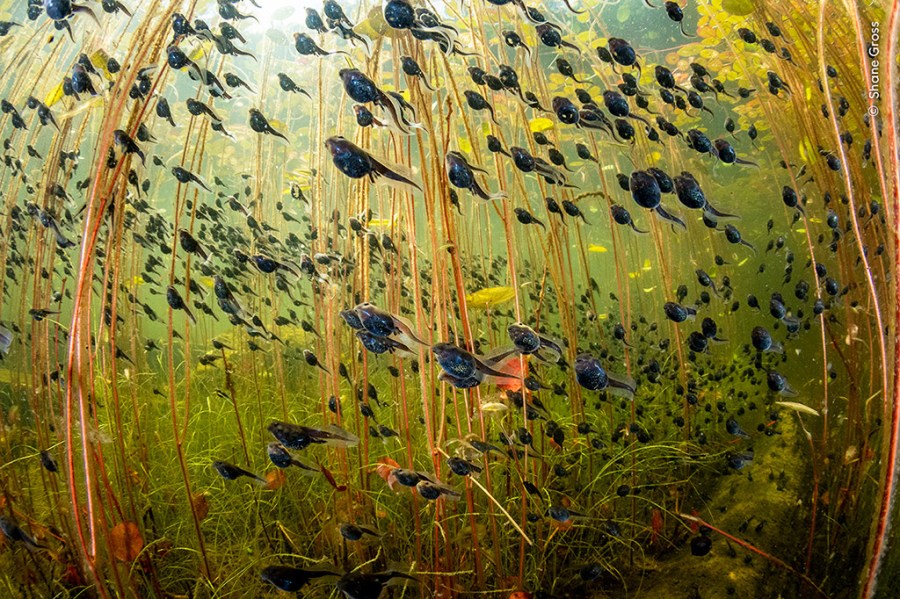The latest Wildlife Photographer of the Year competition winners have been revealed. Congratulations to Shane Gross for winning this year’s overall title with his image of western toad tadpoles. Amy Davies spoke to some of the photographers to find out more about their work…
This year Wildlife Photographer of the Year is celebrating an incredible 60 years. The prestigious competition always attracts the very best of the year’s wildlife photography, and of course 2024 is no different. Since its inception, the competition has always strived to promote wildlife photography as being directly beneficial for the wildlife portrayed within it.
That means that over the years, we’ve seen a noticeable shift away from traditional or classic wildlife shots of common subjects to those that demonstrate the behaviour of perhaps lesser-known creatures, or those which need the most attention. We’ve also seen a lot more in the way of artistic representations of wildlife, as well as an increase in photojournalistic approaches to the topic.
This year, a record-breaking 59,228 entries were submitted to the competition from 117 countries and territories. Entries are judged anonymously for their creativity, originality and technical excellence by a panel of internationally renowned experts.
The overall winners, as well as the Grand Title and Young Grand Title awards, were announced at a ceremony hosted by the wildlife TV presenters and conservationists Chris Packham and Megan McCubbin. For 2024, a new award, the Impact Award, is designed specifically to recognise a conservation success, a story of hope and/or positive change.
The Wildlife Photographer of the Year 60 exhibition at the Natural History Museum, South Kensington, London, will feature one hundred photographs. There will also be a timeline of key moments in the competition’s history to celebrate its special anniversary. Open from 11th October, the exhibition runs until 29 June 2025. A UK and international tour will also commence.
Don’t forget, if you’ve been inspired to enter your own shots into the competition, you’ve still got time. It’s open until 11.30GMT on 5 December. Visit nhm.ac.uk/wpy/competition for more information on both the exhibition and the competition.
Winner, Wetlands: The Bigger Picture and Wildlife Photographer of the Year 2024 – The Swarm of Life by Shane Gross, Canada
Nikon D500, Tokina Fisheye 10-17mm f/3.5-4.5 lens at 11mm, 1/200 at f/13, ISO 640, 2x Sea & Sea strobes, Aquatica housing

After snorkelling in the lake for several hours, through carpets of lily pads, Shane photographed these western toad tadpoles. The tadpoles swim up from the safer depths of the lake to dodge predators to reach the shallows where they feed. The tadpoles start becoming toads between four and 12 weeks after hatching – but an estimated 99% do not survive into adulthood.
Shane has been entering WPY since 2012, and says he feels so honoured to have won his category and finds it hard to fathom that he has been named as the overall winner. He’s especially thrilled considering the subject matter. He says, ‘Wetlands are so overlooked. I’m very happy that WPY added this category recently as wetlands deserve – and more importantly, need – our attention today.’
Speaking about the shot itself, he says, ‘Being among millions of tadpoles in a beautiful setting sounds like it would make for easy photography, and in a way, it was. The difficult thing for me was working out the best way to capture the spectacle. You have very small, dark animals on a bright background, so the key to having them pop was to use a fisheye lens, get really close, and use strobes to light up their spectacular detail.’
Shane’s top tips:
- The more time and effort you put in, the better your results will be. That’s the only way I know of to develop a style of your own, a voice of your own.
- Study the past competition winners so you can be original and have fun with it.
- Enjoy the process entering. I go through my images thinking critically about them and show them to friends and family to see their reactions – it’s very motivating and rewarding.
- If you don’t win (which is most of the time!) don’t take it personally. Many successful images don’t make it.
Winner, 15-17 Years and Young Wildlife Photographer of the Year – Life Under Dead Wood by Alexis Tinker-Tsavalas, Germany
Panasonic Lumix G90, Laowa 25mm f/2.8, 2.5-6x ultra macro lens, 1/200 at f/4, ISO 200, Nikon SB-900 Speedlight flash, Cygnustech macro diffuser, focus stack of 36 images

Alexis needed to work fast to capture this image, as springails can jump many times their body length in a split second. Still, he used focus stacking to shoot 36 images and combine them for a perfectly focused result. The springtail is barely 2mm long, and is found alongside slime moulds and leaf litter all over the world. It improves soil by helping organic matter to decompose.
Speaking of his win, Alexis says, ‘It’s really a big honour – I never thought I would reach the point. I’m also always happy to see macro represented in broader wildlife competitions, as it tends to be an underrepresented genre compared to larger wildlife like birds and mammals.’
Alexis has been photographing since a very young age, with wildlife always being his favourite subject. ‘I was interested in birdwatching and nature and wanted to get better photos to document what I saw. For the first couple of years, my main focus was on bird photography, but I quickly became more interested in macro and getting photos of all kinds of insects, spiders and other tiny organisms.
‘Getting a good image handheld at such high magnifications poses challenges in itself, with the lighting, depth of field and stability all needing special technique and equipment to overcome the limitations of high-magnification shooting. I also got lucky that the springtail didn’t move in the time it took to shoot the 36 images required for the focus stack.
‘I think the biggest impact wildlife photography can have is to educate people about aspects of the natural world they were previously unaware of, and to raise awareness about important conservation efforts. Macro is particularly importantly for this as it gives people another perspective
on smaller wildlife, to help them understand how important it is to protect these organisms that are so vitally important to our ecosystems.’
Alexis’s top tips:
- The most important thing is to go outside in the field as much as you can and keep practising.
- Gear definitely matters to a certain extent, but what is so much more important is having good technique, an eye for composition and to be able to act fast when an opportunity presents itself.
- For competitions, focus on behavioural images rather than just simple wildlife portraits.
Winner, Oceans: The Bigger Picture – A Diet of Deadly Plastic by Justin Gilligan, Australian
Nikon D850, 24-70mm f/2.8 lens, 1/125 at f/11, ISO 400, Profoto B10 + A1 flash
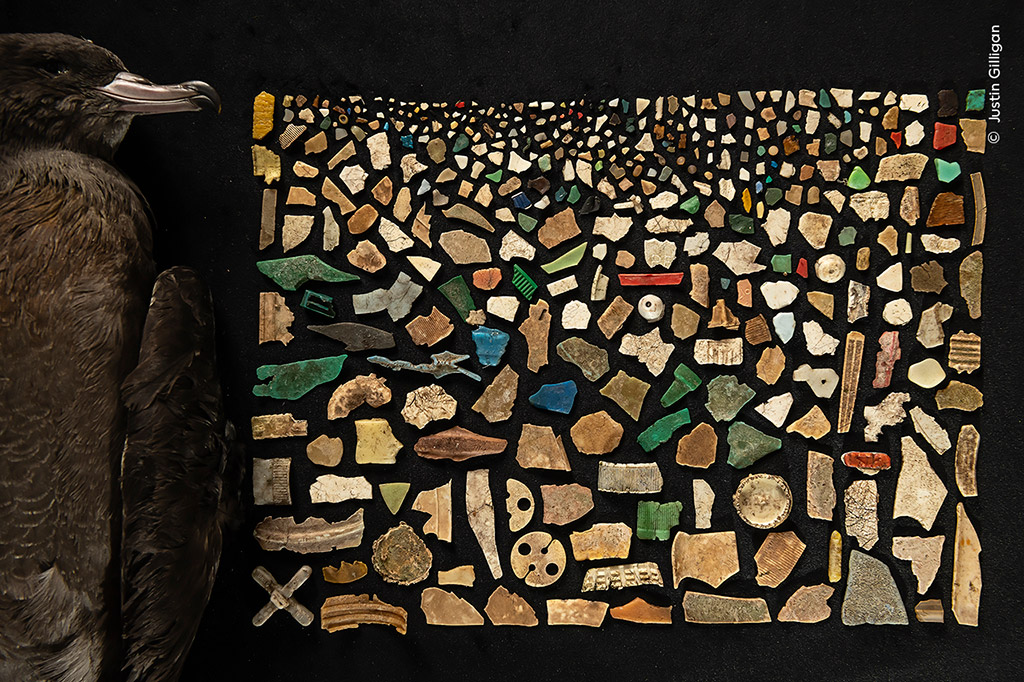
This mosaic was created from the 403 pieces of plastic which were found inside the digestive tract of a dead flesh-footed shearwater. Justin has been working with seabird and marine plastics research group Adrift Lab, documenting their work for several years, including joining them on beach walks at dawn to collect dead chicks. The team includes biologists from around the world, who study the impact of plastic pollution on marine life.
Studies have revealed that three-quarters of adult flesh-footed shearwaters breeding on Australia’s Lord Howe Island, and 100% of fledglings, contained plastic. Research has revealed that the plastic causes scarring to the lining of the digestive tract, a condition known as plasticosis.
Justin is extremely happy to have been recognised by WPY, and particularly this category. He says, ‘I am a member of the International League of Conservation Photographers (iLCP) and my conservation storytelling efforts have largely focused on marine conservation issues. This category was therefore a natural fit for me, and, being a relatively new category, there was an opportunity to try to contribute something a little unusual and surprising to draw the interest of the judges.
‘The challenge for creating this image was establishing a constructive working relationship with Adrift Lab, putting in all the time necessary to represent their hard work and dedication. There are also some difficult emotions to overcome when facing a story and a scene like this – you just need to focus on the task at hand and try to create the most compelling images possible.’
Justin’s top tips:
- Find a subject you are passionate about in the town or region where you live that few other photographers are working on. Become an expert in that subject.
- Visit the subject during all seasons and try and create images that are different from those you’ve seen elsewhere.
- If a particular species or location has been awarded in the competition before, submit images that build on the established standard. You need to come up with something different from a fresh perspective.
Winner, Behaviour: Invertebrates – The Demolition Squad by Ingo Arndt, Germany
Canon EOS 5DSR, 100mm f/2.8 lens, 1/200 at f/8, ISO 400, Canon Macro Twin Lit MT-24EX flash, softboxes

In this shot, we see the brutal and efficient dismemberment of a blue ground beetle by red wood ants. To capture the shot, Ingo lay next to the ant’s nest, after which he described himself as ‘full of ant’ – a skin-crawling description.
The ants’ nourishment mostly comes from honeydew secreted by aphids, but, they also need protein. As such, they are capable of killing insects and other invertebrates much larger than themselves through their strength in numbers.
This is not the first time Ingo has won a category at WPY, but he says, it’s ‘always awesome and a great honour’ to be placed. Having photographed the wood ants for the last two years, it was always obvious to him that he would enter into this category this time around.
Describing the tricky process of capturing the image, he says, ‘In order to get a flat perspective, I had to lie down on the ground right next to the ant nest. Soon, hundreds of ants were sitting on me, biting me and spraying me with formic acid.’
Ingo’s top tips:
- It’s best to concentrate on one subject or theme and not try to photograph everything at once.
- Be selective in your choices and delete as many as possible – the more you delete, the better the pictures are that you keep.
- Take a look at the Wildlife Photographer of the Year portfolio book, you’ll see which type of pictures stand a chance of winning.
Winner, Rising Star Portfolio Award – The Serengeti of the Sea by Sage Ono, USA
Nikon D850, 60mm f/2.8 lens, 1/60 at f/14, ISO 250, Nauticam NA-D850. Housing, 2x Sea & Sea YS-D2J strobes
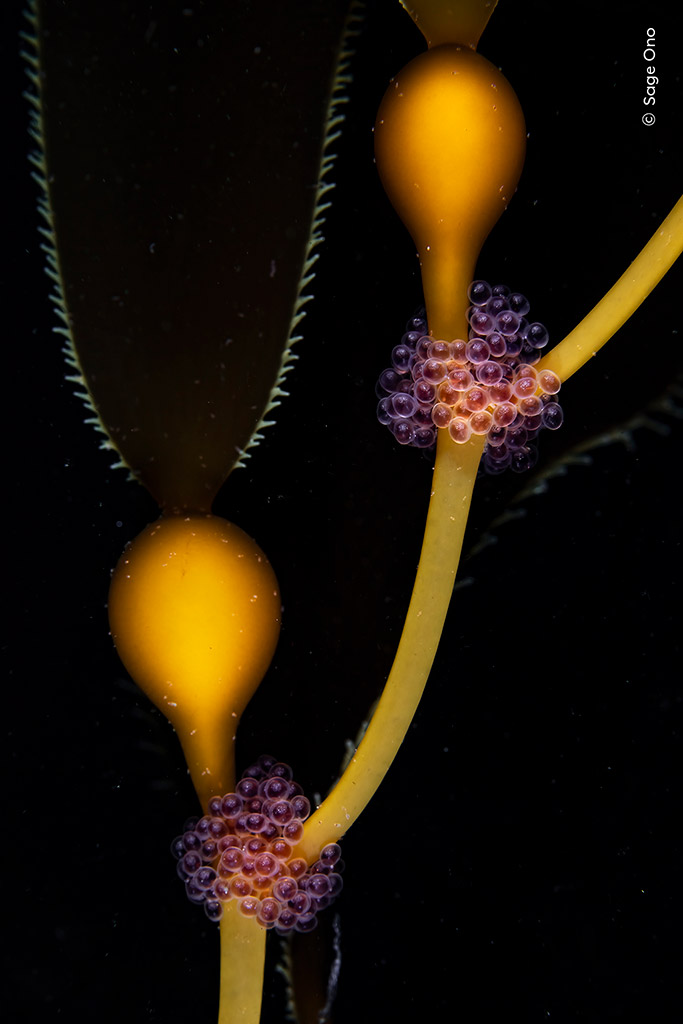
These tube-snout fish eggs sparkle like gems next to the glowing gold of the kelp. As the embryos inside the eggs develop, they will fade in colour. This is an image from Sage’s portfolio which explores the abundant life around the giant kelp forests in Monterey Bay National Marine Sanctuary, California.
Sage is extremely excited to have won a category. He says, ‘It’s exciting and bewildering. I hope this recognition helps give a voice to kelp forests worldwide, and I don’t think I will be able to fully appreciate how winning will affect my life for a few more years.’
Speaking about his winning portfolio, he says, ‘I do most of my shooting in and around Monterey Bay focusing on kelp forests. The Rising Star Portfolio category allowed me to take a broader view and focus on a theme rather than a single moment. Kelp forests are incredibly complex ecosystems, where the life in the canopy is vastly different from the life in the holdfasts. A single image can’t capture that complexity.’
As you can imagine, underwater photography has a diverse range of challenges not always seen in other genres. ‘In order to shoot in Monterey, I have to take my camera, a vacuum-sealed housing, strobes, a drysuit, tank and plenty of other accessories. These make moving underwater quite awkward. Constantly managing my buoyancy in the swell and current in order to frame images is difficult too. It’s far from graceful, but hundreds of hours of practice and a lifetime in the water made it possible.’
Sage’s tips:
- Be relentlessly picky about your own vision. Aim to match the artists you look up to on a technical level, but then try to break away from them stylistically.
- Shoot local, or plan on doing something no one has ever done before. Talented photographers are everywhere, but the best shots almost always come from those who have taken the time to really understand their local ecosystem.
- Slow down, look closely, you’ll find fascinating stories everywhere.
Winner, Behaviour: Mammals – A Tranquil Moment by Hikkaduwa Liyanage Prasantha Vinod, Sri Lanka
Nikon D500, 600mm f/4 lens, 1/250 at f/4, ISO 3200
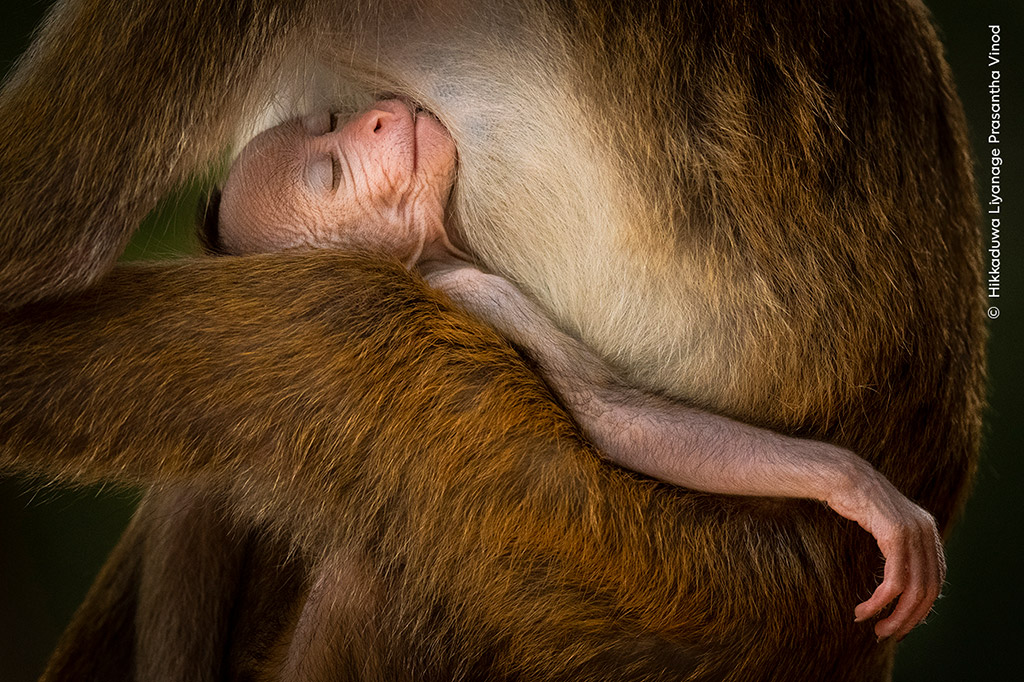
Here we have a sweet portrait of a young toque macaque sleeping in an adult’s arms. While taking a rest after a morning of photographing birds and leopards, the photographer soon realised he wasn’t alone. A troop of toque macaques was moving through the trees above, with a young monkey sleeping between feeds. A telephoto lens enabled Vinod to pick out the peaceful moment.
Despite the obvious beauty of the portrait, Vinod is still somewhat surprised to have won the category. ‘When I received the email acknowledging the win, I could not believe it. I went through the email three times before comprehending it – I’m honoured.’
Long fascinated by primates, due to their human-like behaviours, Vinod says there were a couple of challenges to getting to this shot. ‘One was not to make the mother and the newborn startled by making any unnecessary noise, but at the same time, I knew had to take the shot ASAP because I knew this moment was not going to last long. I had to move swiftly to the right position but without making noise.
‘The second challenge was to hold my gear by hand and take the frame I wanted. I had the Nikon 600mm f/4 prime lens attached to my D500 DSLR. It was a bit of a struggle to hold the set up for long without shaking and to get the best frame I wanted. What I did was to push and hold the set up against a tree and while keeping it steady took the frame I wanted.’
Vinod’s tips:
- Follow other established photographer’s work, for example on Instagram. Try to analyse the lighting, subject, framing and composition and the story it conveys. Learn their methods and excel from them.
- Always plan before you set out to shoot in a park. Find out what animals are in that park, the geography, the sort of lighting that will be there, and what sort of actions you could anticipate.
- When you are a bit more experienced, try to photograph frames which tell a story. Wild animals can’t speak, so we must be their voice.
Winner, Underwater – Under the Waterline by Matthew Smith, UK/Australia
Nikon Z7 II, 14-30mm f/4 lens, 1/200 at f/11, ISO 640, neutral-density graduated filter, Aquatica AZ6/7 housing and Matty Smith 12” split shot dome port, Sea & Sea YS-D3 Mark II strobes
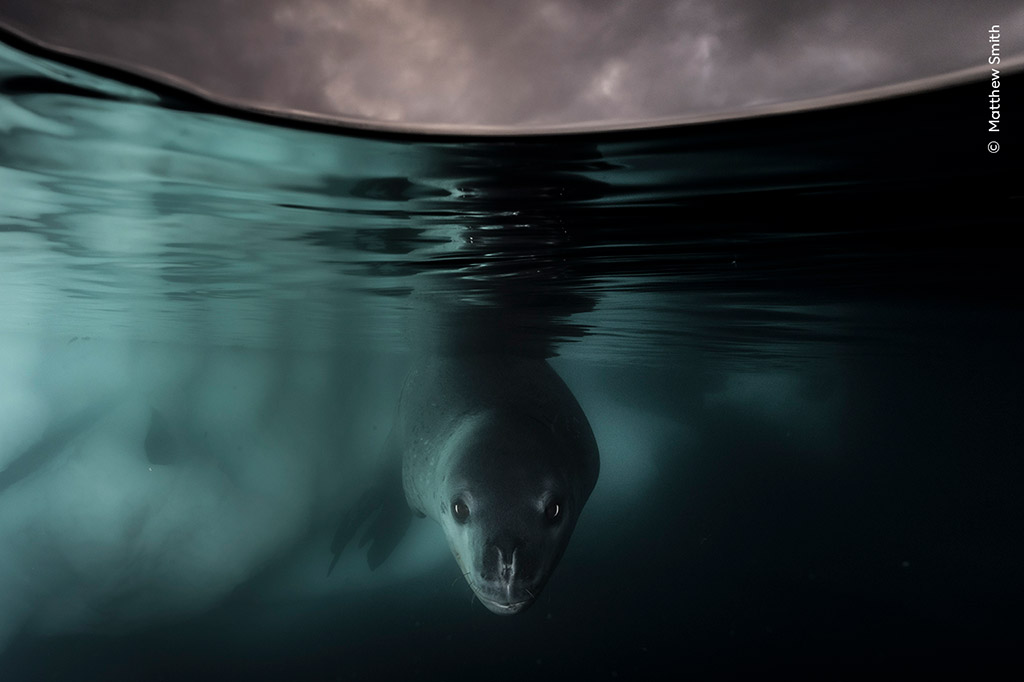
This curious leopard seal is seen beneath the Antarctic ice. Matthew captured this using a specially made extension designed for the front of his underwater housing to get the split image – and amazingly, it was his first encounter with a leopard seal. He says, ‘When it looked straight into the lens barrel, I knew I had something good.’
Leopard seals are widespread and abundant, but overfishing, retreating sea ice and warming waters mean that krill and penguins – the main source of food for the seals – are both in decline.
He describes winning this category as a career highlight. ‘WPY is considered the Oscars of wildlife photography and to be selected as a winner is a “pinch myself” moment. I still don’t quite believe it,’ he says.
Although this is a winning image, Matthew actually entered multiple categories with many pictures this year. However, as he exclusively shoots underwater, he feels especially honoured to win in this category.
‘Location and extreme cold were the two biggest challenges to get this shot. It was taken in a remote spot on the Antarctic peninsula, only really accessible on a small yacht like ours, out of reach of the bigger cruise ships.
‘A small group of seven photographers and I chose to sail there from Argentina on a small boat so we could run to our own schedule and spend time in these hard-to-reach locations. We were living on the vessel in cramped quarters for a month, which was mentally and physically challenging.
‘Crossing Drake Passage between South America and Antarctica is also an extreme sailing adventure as is notoriously one of the most treacherous oceans to cross. Once there we had to deal with sub-zero ocean temperatures, which makes it hard to shoot underwater. Time is limited as even with the best dry suit and thermal gear, the iciness creeps into your bones very quickly, making operating a camera very tricky.’
This is not the first time Matthew has been published in AP. Matthew recalls, ‘Amateur Photographer was the first magazine to publish a print of mine almost 25 years ago! It was a black & white print of the Sydney Harbour Bridge that I shot on my first trip to Australia (before I emigrated). I remember how excited I was and how it gave me a boost to push on with my photography. Little did I know the next picture of mine you’d publish would be a WPY award-winning image, which makes this interview extra special indeed.’
Matthew’s tips:
- Patience is paramount; these things don’t happen overnight. Get to know your target species well, and its behaviour and nuances. Studying the animal will help you capture the more special moments.
- Good eye contact with your subject makes for compelling images.
- For competitions, read the rules carefully. For example, WPY is very particular about post-processing – which is a good thing.
- Shooting for awards like this helps to make you a better and more thoughtful photographer, but it’s a tough competition. Don’t be put off if you don’t make it; keep entering year after year.
Further reading:
- Dusk to Dawn – Share your low light photos to win a £500 voucher!
- The Nikon Comedy Wildlife Awards shortlist is here!
- Impactful conservation photo wins Bird Photographer of the Year
- Amateur Photographer Student Roadshow 2024 coming soon!
Follow AP on Facebook, Twitter, Instagram, YouTube and TikTok.

